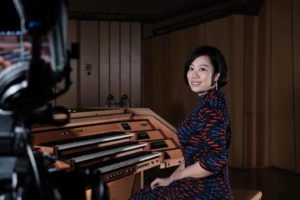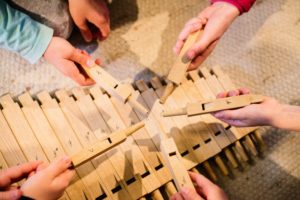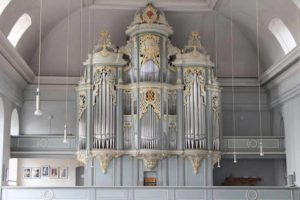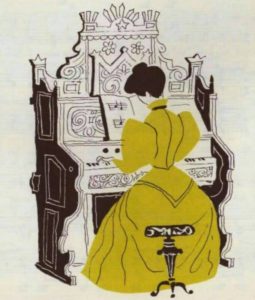Orgelkids China執行長蔣士挺(Justin Berg)「兒童管風琴教育專欄」【初因初音】。
『Aristide Cavaille-Coll』from the column【My First Sound】 by Justin Berg, the Executive Director of Orgelkids China. (In English below)
古典法國管風琴的建造風格上比較一致,形成相對標準化的設計發展 (以凡爾賽宮的皇家管風琴為例,圖1)。雖然簧管加上疊高的短號(8呎+4呎+2 2/3呎+2呎+1 3/5呎)發出的聲音很容易傳入耳中,古典法國管風琴真正的獨奏聲音是——使用全部音栓組合(Plein jeu,圖2),就是主音管基礎音栓合奏加上混合音管。Plein jeu是15-18世紀法國最主要的混合音栓裝置,音響既莊嚴又優美。Plein jeu與簧管和短號音管不同,並不會模仿例如小號之類的樂器聲音,其特有的音色,是結合音管的材質、尺寸排列、整音與調音,加上混合音栓而得到的。古典的八呎主音管在法文稱為Montre(意思是「表現」,因為這些音管可以從外觀看到,圖3),是用錫合金製造的,管形偏窄,聲音較溫和從容。四呎主音管Prestant的形狀也類似。因為這兩列音管的製作原料都含有大量的錫,別的國家的管風琴主音管則是含鉛量較高,可以擦亮而讓管風琴的外觀亮麗,而較窄尺寸的音管產生的音色就是有豐富泛音的明亮音色。(尺寸就是指音管的寬度相對於長度的比例,通常較窄的音管會突顯泛音,較寬的音管則會加強基礎音或單音的音高。)我們知道,Plein jeu是十七世紀和十八世紀的管風琴家非常重視的音栓組合法,因為當時幾乎所有法國音樂組曲(除了聖誕頌歌以外)慶典儀式都是用這種典型的混合主音栓組合開展。
Plein jeu除了會使用所有的八呎、四呎、二呎的主音音管,還會加上混合音栓,包含較低音的基礎音栓和較高音的泛音系列音管組合。或許你還記得,混合音栓通常都是高音,在十七世紀和十八世紀的管風琴上,八呎管風琴(主風琴上最低的基礎音栓是八呎音栓,不同於十六呎或三十二呎的手鍵盤基礎音栓)所用的混合音栓通常是從1 1/3呎開始(比同度音更高兩個八度加一個完全五度)。法國管風琴的基礎音栓也與其他國家的管風琴相同,通常是從兩呎的高音音栓開始,但是法國泛音高頻音管組合的音高就比德國低。將明亮的主音管與較低的混合音栓結合起來而得到的效果,就是較低的混合音栓可以強化主音管的低音。換言之,這個時期的法國管風琴主音管的低音很容易失去些許清晰度,要加上混合音栓使之變得清楚,這樣的Plein jeu音栓合奏得到的效果就很莊嚴雄偉。主音管加上混合音栓的基礎音效並不適合複音音樂織體,這也成為法國管風琴不同於歐洲其他傳統的另一個特點。的確,為這種音栓組合法而譜寫的樂曲,會把這種低沉的聲音運用在緩慢行進的和弦中,有時會以腳鍵盤的八呎燦爛簧片音管獨奏來強調(見圖2, pedale)。
將這些法國管風琴與其他國家同時期的管風琴相比,就會看到腳鍵盤也有一些很有意思的現象。這些腳鍵盤通常很短,只能以腳趾演奏(圖4),不像德國管風琴可以用到腳趾和腳跟。這種設計曾造成誤解,讓人以為這個時期的法國管風琴在腳鍵盤部分並沒有高超的技藝,不像布克斯特胡德和巴哈等大師的作品。但我們只要看看馬尚 (Marchand)的雙音腳鍵盤卡農 (Plein jeu with a canon in double pedals),或是葛里尼 (Grigny)的賦格四聲部對位,就會了解如果想在腳鍵盤上優美地演奏這些形式的樂曲,都會明白其中所需要的技巧極具挑戰性,確實要有相當精湛的技藝。(待續)
你的朋友蔣士挺
〜Aristide Cavaille-Coll (part I) continued (2)〜
Though the sound of these reeds with the mounted Cornet easily captivates the ear, the true voice of the Classical French organ is the Plein jeu, the principal chorus with mixtures. In these organs, this registration is distinguished by a sound that is as serious as it is elegant. Unlike the reeds and Cornet, the Plein jeu does not imitate other instruments, such as the trumpet. It is a sound unique to these organs that results from a marriage of pipe material, scaling and voicing, and the composition of the mixtures. The classic 8’ principal stop, called Montre (meaning”to sho”, as these pipes were visible in the façade), was made from a metal alloy rich in tin, with relatively narrow scales, and somewhat gentle, unhurried voicing. The 4’ principal, Prestant, was similarly fashioned. Because both of these ranks of were made with a generous amount of tin, as opposed to the high lead content typical in other countries’ organs, they could be burnished to make them shine in the organ’s facade. This fact combined with their narrow scaling to produce a bright timbre with plentiful overtones. (Note: Scaling just means how wide or narrow pipes are compared to their length. Generally, narrower scaling highlights overtones, while wider scaling emphasizes the fundamental, or unison pitch.) We know that the Plein jeu was a highly prized registration by organists throughout the seventeenth and eighteenth centuries because virtually every suite of French music from that time (except suites of Noëls) began with this combination of stops.
Above the 8’ Montre, 4’ Prestant and 2’ Doublette (all principals), two mixtures were added to create the Plein jeu: the lower-pitched Fourniture and its higher counterpart, the Cymbale. You probably remember that mixtures are generally high-pitched anyway. In seventeenth- and eighteenth-century organs, the mixtures used on 8-foot organs (i.e. organs wherein an 8-foot stop is the lowest principal on the Great, as opposed to a 16 or 32-foot manual principal) typically began at 1⅓’ (that is two octaves and a perfect fifth above unison). It was also often the case that the French Fourniture began at a pitch just above the 2’ Doublette, much like organs in other countries. By comparison, however, the French Cymbale was pitched somewhat lower than its Germanic counterparts. The effect of combining bright principals with relatively low mixtures was that the latter could help to reinforce the bass of the former. In other words, French principals from this time tended to lose some of their definition in the bass, which was then clarified by the addition of the mixtures. The musical effect then of this Plein jeu is a sound that is majestic. This fundamental sound of principals and mixtures together was not suited to polyphonic textures, which is another aspect distinguishing these organs from those of other traditions throughout Europe. Indeed, the music written for this registration employs the gravity of this sound for slow-moving chords, sometimes punctuated by a pedal solo played on an 8’ Trompette.
Again comparing these French instruments to those of other national schools of the same time, we find some interesting facts regarding their Pedale divisions. The pedal keys themselves were typically rather short, and thus only playable by the toe of the foot, rather than both toe and heel as was the case in German instruments. This design has prompted the misconception that French organ music from this period does not make virtuosic use of the pedals, as was the case with composers such as Buxtehude and Bach. However, we have only to look at the double pedal movements composed by Marchand or the contrapuntal textures of a Quatuor or a de Grigny Fugue: anyone who has attempted to play these pieces beautifully on pedals of such size and shape knows how challenging the required technique can be. Indeed, they demand a virtuosity all their own. (To be continued.)
Your Friend,
Justin





